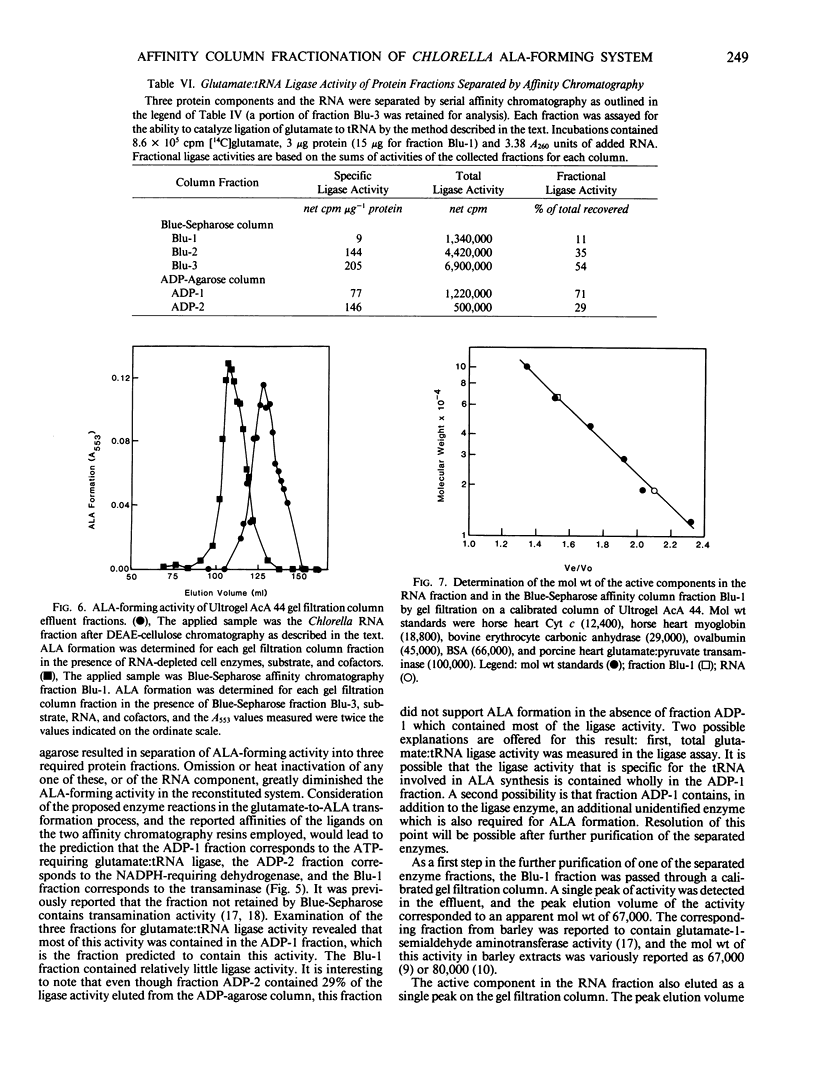Abstract
Extracts from plant chloroplasts and algae catalyze the conversion of glutamate to δ-aminolevulinic acid (ALA) in the first committed step of the tetrapyrrole biosynthetic pathway leading to chlorophylls, hemes, and bilins. The conversion requires ATP, Mg2+, and NADPH as cofactors. Soluble extracts from Chlorella vulgaris have now been resolved into four macromolecular fractions, all of which are required to reconstitute activity. One fraction contains a low molecular weight RNA which can be separated from the protein components in an active high-speed supernatant by treatment with 1 molar NaCl followed by precipitation of the proteins with (NH4)2SO4 at 70% saturation. The proteins recovered from the (NH4)2SO4 precipitate are reactivated by addition of a fraction containing tRNAs isolated from Chlorella by phenol-chloroform extraction and DEAE cellulose chromatography. Three required protein fractions were resolved from the RNA-depleted (NH4)2SO4 precipitate by serial affinity chromatography on Reactive Blue 2-Sepharose and 2′,5′-ADP-agarose. Glycerol was found to stabilize the enzyme activity during the separation process. The majority of the glutamate:tRNA ligase activity was associated with the fraction which was retained by Blue-Sepharose and not retained by ADP-agarose, in agreement with the reported properties of the affinity ligands. The active material in the fraction not retained by Blue-Sepharose eluted as a single component on gel filtration chromatography, with an apparent molecular weight of 67,000. The active component in the RNA fraction also eluted as a single component on gel filtration chromatography.
Full text
PDF






Selected References
These references are in PubMed. This may not be the complete list of references from this article.
- Bradford M. M. A rapid and sensitive method for the quantitation of microgram quantities of protein utilizing the principle of protein-dye binding. Anal Biochem. 1976 May 7;72:248–254. doi: 10.1016/0003-2697(76)90527-3. [DOI] [PubMed] [Google Scholar]
- Damuni Z., Caudwell F. B., Cohen P. Regulation of the aminoacyl-tRNA synthetase complex of rat liver by phosphorylation/dephosphorylation in vitro and in vivo. Eur J Biochem. 1982 Dec;129(1):57–65. doi: 10.1111/j.1432-1033.1982.tb07020.x. [DOI] [PubMed] [Google Scholar]
- Huang D. D., Wang W. Y. Chlorophyll biosynthesis in Chlamydomonas starts with the formation of glutamyl-tRNA. J Biol Chem. 1986 Oct 15;261(29):13451–13455. [PubMed] [Google Scholar]
- Huang D. D., Wang W. Y., Gough S. P., Kannangara C. G. delta-Aminolevulinic acid-synthesizing enzymes need an RNA moiety for activity. Science. 1984 Sep 28;225(4669):1482–1484. doi: 10.1126/science.6206568. [DOI] [PubMed] [Google Scholar]
- MAUZERALL D., GRANICK S. The occurrence and determination of delta-amino-levulinic acid and porphobilinogen in urine. J Biol Chem. 1956 Mar;219(1):435–446. [PubMed] [Google Scholar]
- Ohashi Ziro, Harada Fumio, Nishimura Susumu. Primary sequence of glutamic acid tRNA II from Escherichia coli. FEBS Lett. 1972 Feb 1;20(2):239–241. doi: 10.1016/0014-5793(72)80804-4. [DOI] [PubMed] [Google Scholar]
- Schön A., Krupp G., Gough S., Berry-Lowe S., Kannangara C. G., Söll D. The RNA required in the first step of chlorophyll biosynthesis is a chloroplast glutamate tRNA. Nature. 1986 Jul 17;322(6076):281–284. doi: 10.1038/322281a0. [DOI] [PubMed] [Google Scholar]
- URATA G., GRANICK S. Biosynthesis of alpha-aminoketones and the metabolism of aminoacetone. J Biol Chem. 1963 Feb;238:811–820. [PubMed] [Google Scholar]
- Wang W. Y., Huang D. D., Stachon D., Gough S. P., Kannangara C. G. Purification, Characterization, and Fractionation of the delta-Aminolevulinic Acid Synthesizing Enzymes from Light-Grown Chlamydomonas reinhardtii Cells. Plant Physiol. 1984 Mar;74(3):569–575. doi: 10.1104/pp.74.3.569. [DOI] [PMC free article] [PubMed] [Google Scholar]
- Weinstein J. D., Beale S. I. Enzymatic conversion of glutamate to delta-aminolevulinate in soluble extracts of the unicellular green alga, Chlorella vulgaris. Arch Biochem Biophys. 1985 Mar;237(2):454–464. doi: 10.1016/0003-9861(85)90299-1. [DOI] [PubMed] [Google Scholar]
- Weinstein J. D., Beale S. I. RNA is required for enzymatic conversion of glutamate to delta-aminolevulinate by extracts of Chlorella vulgaris. Arch Biochem Biophys. 1985 May 15;239(1):87–93. doi: 10.1016/0003-9861(85)90814-8. [DOI] [PubMed] [Google Scholar]
- Weinstein J. D., Beale S. I. Separate physiological roles and subcellular compartments for two tetrapyrrole biosynthetic pathways in Euglena gracilis. J Biol Chem. 1983 Jun 10;258(11):6799–6807. [PubMed] [Google Scholar]
- Weinstein J. D., Mayer S. M., Beale S. I. Stimulation of delta-Aminolevulinic Acid Formation in Algal Extracts by Heterologous RNA. Plant Physiol. 1986 Dec;82(4):1096–1101. doi: 10.1104/pp.82.4.1096. [DOI] [PMC free article] [PubMed] [Google Scholar]
- Yasukochi Y., Masters B. S. Some properties of a detergent-solubilized NADPH-cytochrome c(cytochrome P-450) reductase purified by biospecific affinity chromatography. J Biol Chem. 1976 Sep 10;251(17):5337–5344. [PubMed] [Google Scholar]


